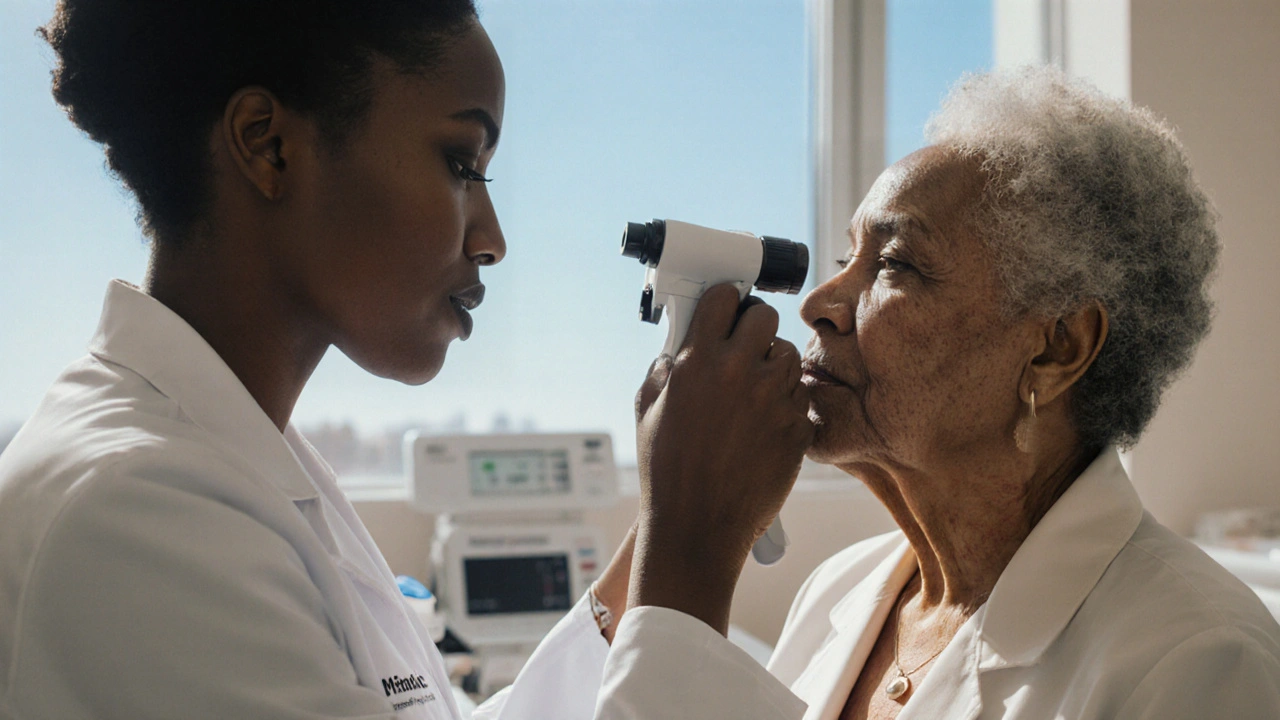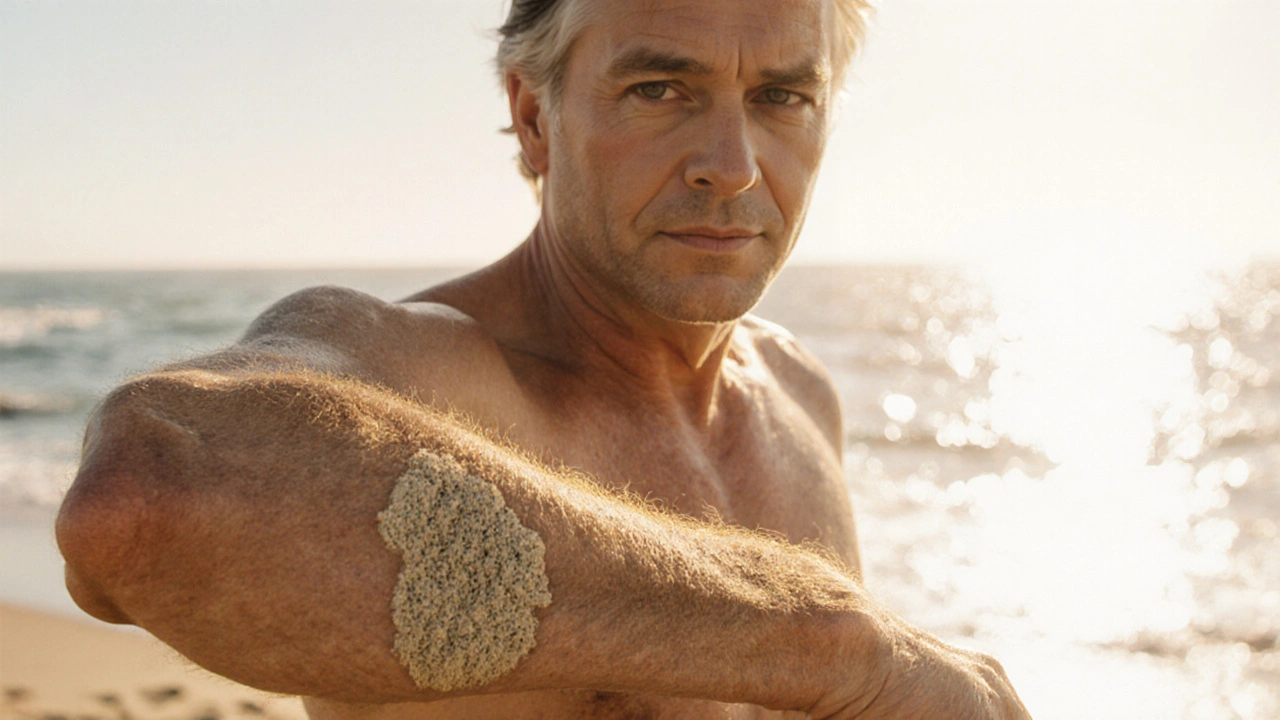Actinic Keratosis Risk Assessment Quiz
1. How often do you spend time outdoors without sun protection?
2. What is your skin type?
3. Have you ever had a blistering sunburn before age 20?
4. Are you over 40 years old?
5. Do you work outdoors regularly?
Living under a bright sun can leave more than just a tan-it can give rise to rough spots and uneven color on your skin. Understanding how actinic keratosis interacts with skin pigmentation helps you spot problems early and act before they turn serious.
Quick Takeaways
- Actinic keratosis (AK) is a precancerous skin growth caused by chronic UV exposure.
- UV damage can both trigger AK and alter melanin distribution, leading to hyper‑ or hypopigmentation.
- Early detection by a dermatologist is key; treatments range from freezing to topical creams.
- Broad‑spectrum sunscreen, protective clothing, and regular skin checks are the most effective prevention tools.
- Even after treatment, monitoring pigmentation changes is essential to catch any recurrence.
What Is Actinic Keratosis?
When you notice a actinic keratosis a small, rough, scaly patch that appears on sun‑exposed skin, you’re looking at a lesion caused by years of ultraviolet (UV) radiation breaking down skin DNA. Most AKs are less than 1cm in size, feel gritty when you run a fingernail over them, and may be pink, red, or flesh‑colored. While each lesion has a low chance (less than 1%) of turning into squamous cell carcinoma, the risk rises with the number of AKs you have.
How AK Affects Skin Pigmentation
UV radiation does two things at once: it damages the DNA of skin cells (leading to AK) and it disrupts the normal production of melanin, the pigment that gives skin its color. This disruption can create three common patterns:
- Post‑inflammatory hyperpigmentation (PIH): After an AK is treated or inflamed, the area may darken as melanin over‑produces.
- Hypopigmentation: The lesion itself can destroy melanocytes, leaving a lighter spot that persists even after the AK is removed.
- Mixed changes: Some people develop a speckled appearance where dark and light patches coexist, especially if they have a history of frequent sunburns.
These pigment shifts are not just cosmetic; they can mask new AKs, making early detection harder. That’s why dermatologists examine both texture and color when they do a skin check.
Risk Factors & Who’s Most at Risk
Everyone who spends time outdoors is exposed to UV radiation, but certain groups develop AK more often:
- Fair‑skinned individuals with low melanin levels - they burn easily and tan poorly.
- People over age 40 - cumulative sun exposure adds up.
- Outdoor workers (construction, farming, lifeguards) - prolonged, unprotected exposure.
- History of blistering sunburns before age 20 - early DNA damage sets the stage.
- Immune‑suppressed patients (organ‑transplant recipients, long‑term corticosteroid users) - their skin heals slower.
If you recognize any of these, schedule regular skin examinations and ramp up your sun‑safety routine.

Diagnosis & When to See a Dermatologist
A dermatologist can diagnose AK through a visual exam and, if needed, a dermatoscope-a handheld magnifier that highlights blood vessels and pigment patterns. In uncertain cases, a skin biopsy confirms whether the lesion is benign, precancerous, or already malignant.
Make an appointment if you notice any of the following:
- Rough, sandpaper‑like patches that don’t improve with moisturizers.
- Newly appearing spots that are red, brown, or skin‑colored and feel firm.
- Any change in the size, shape, or color of an existing spot.
Early treatment not only removes the precancerous cells but also limits pigment disturbances caused by inflammation.
Treatment Options
Several evidence‑based methods clear AKs, each with its own impact on pigmentation. Below is a quick comparison to help you discuss the best fit with your dermatologist.
| Method | How It Works | Typical Sessions | Pros | Cons | Cost (USD) |
|---|---|---|---|---|---|
| Cryotherapy | Freezes lesion with liquid nitrogen, causing cell death. | 1‑2 minutes per spot; often single visit. | Fast, minimal downtime. | May cause temporary hypopigmentation. | $150‑$300 per session |
| Topical 5‑Fluorouracil (5‑FU) | Chemical that disrupts DNA synthesis in abnormal cells. | Apply twice daily for 2‑4 weeks. | Effective for multiple lesions. | Redness, erosion, possible PIH. | $200‑$500 per course |
| Imiquimod Cream | Stimulates immune response to clear abnormal cells. | Apply 3‑times weekly for 6‑16 weeks. | Non‑invasive, good for field treatment. | Inflammation, itching, lingering pigmentation changes. | $300‑$600 per tube |
| Photodynamic Therapy (PDT) | Photosensitizer applied, then activated with specific light. | One‑day procedure; sometimes a repeat after 1‑2 weeks. | Treats large areas, cosmetically favorable. | Potential for mild burning and post‑treatment hyperpigmentation. | $800‑$1,500 per session |
| CO₂ Laser | Precisely vaporizes lesion layers. | Usually single session. | High precision, minimal scarring. | May cause temporary hypopigmentation, higher cost. | $1,000‑$2,500 per treatment |
Discuss these trade‑offs with your dermatologist a medical professional specialized in skin health. The choice often depends on the number of lesions, location on the body, and how much pigment change you’re willing to tolerate.
Prevention Strategies That Keep Both AK and Pigmentation Issues at Bay
Prevention is cheaper and less invasive than treatment. Here’s a checklist you can follow year‑round:
- Broad‑spectrum sunscreen blocks UVA and UVB rays: Apply SPF30 or higher 15 minutes before heading outdoors, and reapply every two hours.
- Wear protective clothing: Long sleeves, wide‑brim hats, and UV‑blocking sunglasses reduce direct exposure.
- Avoid peak sun hours (10am‑4pm) when UV intensity peaks.
- Seek shade whenever possible, especially on beach days or during outdoor sports.
- Regular skin self‑exams: Use a handheld mirror to scan hard‑to‑see areas (back, scalp).
- Schedule professional skin checks at least once a year, or more often if you’ve had AK before.
These habits not only lower the chance of new AKs but also help maintain an even skin tone, preventing long‑term pigment disorders.
Living With AK: Lifestyle Tips and Common Myths
Many people think that once an AK is treated, the problem is over. In reality, the skin that’s been damaged continues to be vulnerable.
- Myth: “If a spot looks “just a freckle,” it’s harmless.” Fact: Early AK can mimic freckles; a dermatologist’s dermatoscope reveals the difference.
- Myth: “Sunscreen isn’t needed on cloudy days.” Fact: Up to 80% of UV rays penetrate clouds.
- Myth: “Only sun‑bathers get AK.” Fact: Cumulative exposure from daily activities adds up.
Adopting a vigilant mindset-checking skin monthly, reapplying sunscreen, and staying aware of new spots-keeps you ahead of both AK and unwanted pigmentation changes.
Frequently Asked Questions
Can actinic keratosis turn into skin cancer?
Yes, although the individual risk per lesion is low (under 1%), having many AKs raises the overall chance of developing squamous cell carcinoma. Early treatment removes the precancerous cells and reduces this risk.
Why does my skin look darker after AK treatment?
Inflammation from treatments like cryotherapy or topical creams can trigger post‑inflammatory hyperpigmentation. This is a temporary increase in melanin that usually fades over weeks to months.
Is sunscreen enough to prevent actinic keratosis?
Sunscreen is the cornerstone of prevention, but it works best when paired with protective clothing, shade, and regular skin checks. No single method can guarantee zero risk.
How often should I see a dermatologist if I’ve had AK before?
Most experts recommend a full‑body exam every 6‑12months for anyone with a history of AK. If you develop new lesions quickly, schedule an earlier visit.
Can natural remedies like tea tree oil clear actinic keratosis?
There’s no strong clinical evidence supporting over‑the‑counter oils or herbs for treating AK. Relying on proven medical therapies is safer and more effective.
By staying informed about how actinic keratosis interacts with skin pigmentation, you can catch issues early, choose the right treatment, and keep your skin looking healthy for years to come.


Graham Holborn
Hi, I'm Caspian Osterholm, a pharmaceutical expert with a passion for writing about medication and diseases. Through years of experience in the industry, I've developed a comprehensive understanding of various medications and their impact on health. I enjoy researching and sharing my knowledge with others, aiming to inform and educate people on the importance of pharmaceuticals in managing and treating different health conditions. My ultimate goal is to help people make informed decisions about their health and well-being.